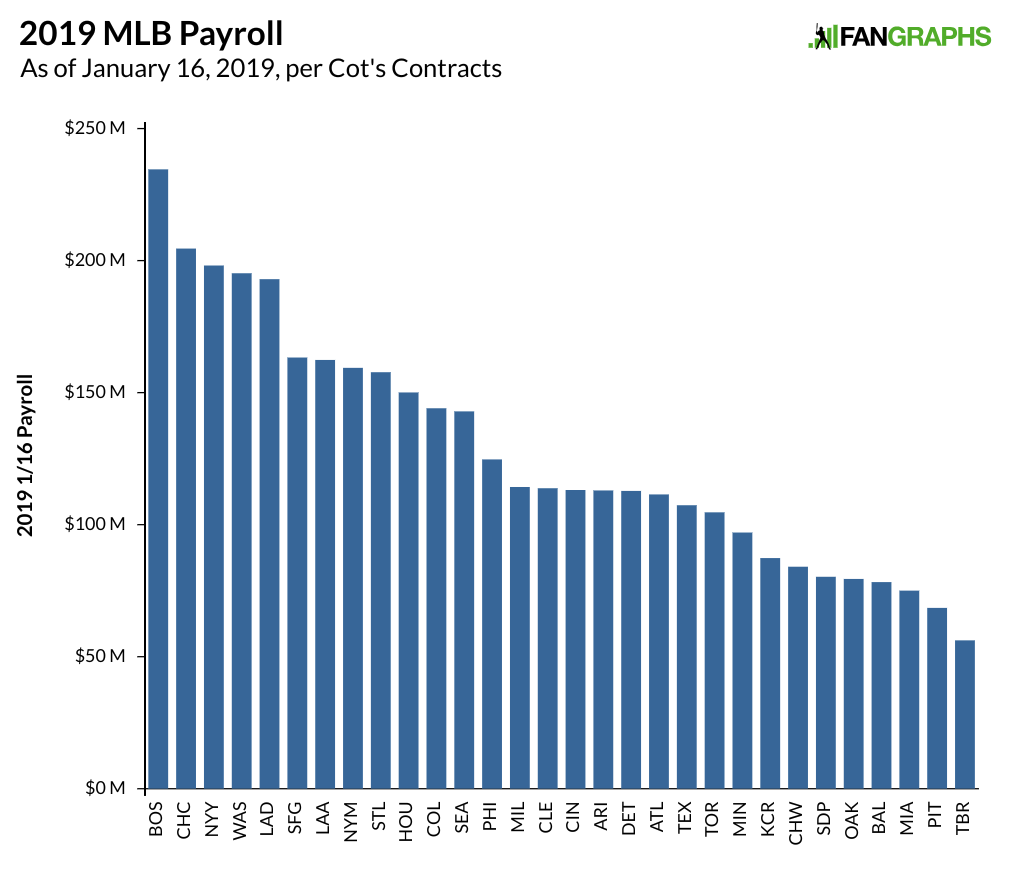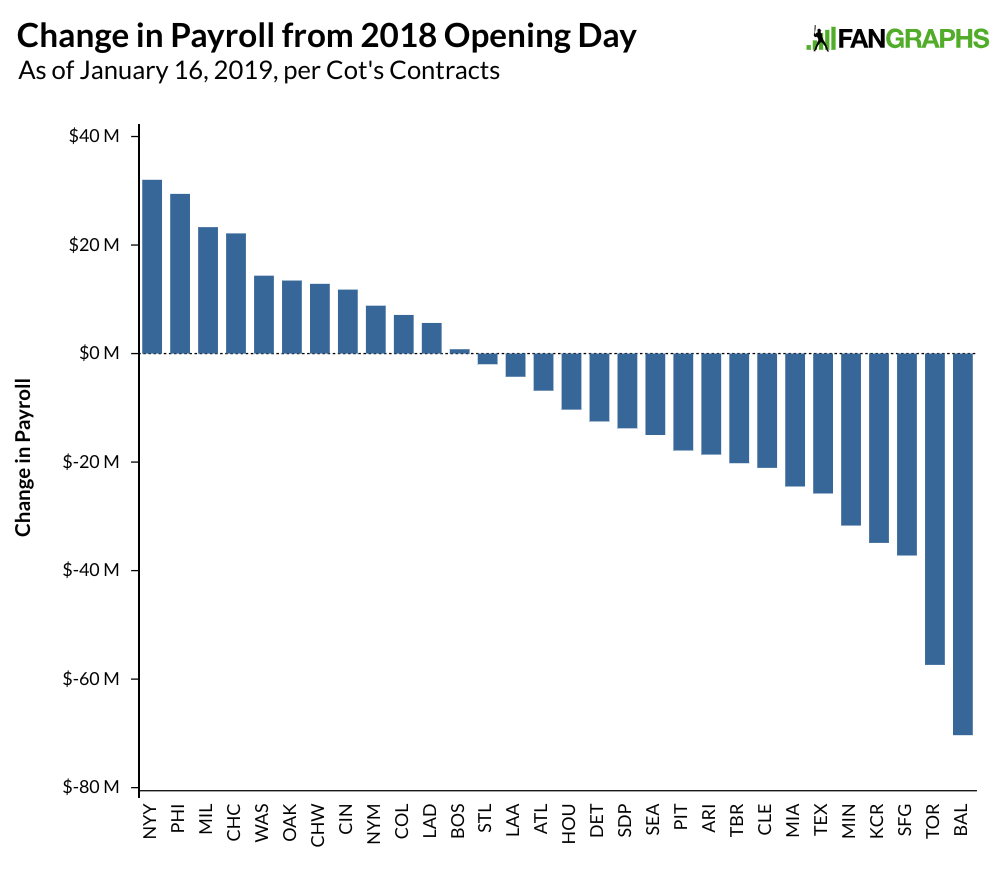In our Introduction, we reviewed some of the issues attendant with the salary arbitration system. Today, we begin to examine solutions. As the system exists currently, I would argue that the largest difference between salary arbitration in baseball and arbitration of the type you see in other disputes is the requirement that the arbitrators must select the position of one side or the other in toto, a feature that seems at odds with arbitration’s goal of helping the parties reach compromise. As MLB’s online glossary explains (emphasis mine):
If the club and player have not agreed on a salary by a deadline in mid-January, the club and player must exchange salary figures for the upcoming season. Unsurprisingly, the club files a lower number than the player does. After the figures are exchanged, a hearing is scheduled in February. If no one-year or multi-year settlement can be reached by the hearing date, the case is brought before a panel of arbitrators. After hearing arguments from both sides, the panel selects either the salary figure of either the player or the club (but not one in between) as the player’s salary for the upcoming season.
This “either/or” approach is unique not just in sports but in arbitration generally. Even the National Hockey League, the only other major North American sport to utilize an arbitration system, doesn’t bind the team and player to only those two options. As one NHL agent explained:
Hockey, unlike baseball, does not have final offer arbitration whereby an arbitrator is bound to pick one side’s proposal or the other. The arbitrator, under current guidelines, is free to pick their own level of compensation anywhere between the two requests.
Hockey’s system, by allowing more freedom to arbitrators in selecting salary figures, granting award rejection rights (in many, but not all, arbitration settings, the losing party has the right to reject the award, at which point various other means ranging from litigation to mediation to a second arbitration are used to reach a resolution), and setting caps on the number of arbitration hearings allowed per team, is substantially more in line with traditional arbitration in other settings. It’s therefore no surprise that hockey has substantially fewer arbitration hearings each year than baseball does.
So why does the ability to select a different number matter? Because the current system in baseball actually incentivizes teams to proceed to hearings, a reality that many teams are now taking advantage of with “file-and-trial” approaches. Consider: as attorney Justin Sievert explained for the Sporting News, when an arbitrator is bound to choose one number or the other, “the panel will choose the offer that is closer to what they believe is the player’s true arbitration value.” To show how this creates issues, let’s look at Dellin Betances‘ 2017 arbitration hearing with the Yankees – the one that had Randy Levine so riled up. Betances asked for $5 million; the Yankees countered with $3 million. Let’s say that the panel had concluded Betances was worth $3.95 million. Under current rules, the Yankees win the hearing – and, by extension, are able to pay Betances less than what he has been deemed worth as a result of submitting a lowball figure.
Now you might think that players also benefit from this margin of error: after all, teams that lose arbitrations arguably end up overpaying their players. But that’s not really how it ends up working, for several reasons. First, teams are allowed by the league to confidentially coordinate arbitration filings and salaries, the effects of which can linger long after an individual player’s case is resolved. Per Jeff Passan:
While MLB works diligently and impressively to coordinate the arbitration targets of its 30 teams — this behavior is sanctioned under the collective bargaining agreement and not considered collusive — agents occasionally make far-under-target settlements. The effect, in a comparison-based system, is devastating: A bad settlement can linger and depress prices at a particular position for years.
Why do we care that teams coordinate filings? Because agents, who are in competition for the same clients, clients with disparate individual interests, don’t achieve the same level of cohesion. Imagine, if you will, that you’re an employee looking for a job. You’ve received three offers from three different employers for roughly the same position. Now imagine that those three employers talked amongst themselves, and decided to make you exactly the same offer for each position. And, to make things more interesting, imagine that they are also collaborating to set the salaries for the other candidates, too. You wouldn’t have much in the way of leverage to make salary demands. The three employers have set the market for your salary, and your ability to effectively counteroffer has been essentially rendered moot.
Now, you might point out that, unlike our job example, arbitration isn’t a free market. The Cubs can’t compete with the Nationals over Kyle Barraclough. But what the Cubs can do is agree with the Nationals on what a Kyle Barraclough is worth. Why do we care? Because arbitration is a comparisons-based system. The current system allows teams to, in essence, work together to set the prices for the comparables their own players will cite. The teams are coordinating amongst themselves to drive down prices for all players, because every player is a comparable for someone, and the teams have set prices for everyone.
The trouble is that agents have no way of knowing what those internal calculations are until after all of the arbs are finished in a given year. Another way to look at this is to consider that teams are building their own valuation tool in arbitration, one that is universal across teams, is position- and comparable-adjusted, and – most importantly – is internally consistent and predictable. Agents’ numbers don’t have that level of cohesion. So when teams enter arbitration with consistent numbers, and players don’t, it’s the players’ requests that appear out of step with the realities of the market. The either/or arbitration system facilitates that trend.
This knowledge gap creates a structural mismatch in favor of teams, a mismatch that shown itself in arbitration outcomes. Players who went to arbitration last winter did fairly well in their cases, and Passan cited an oft-used statistic that “[t]he league historically has won well more than 50 percent of cases.” But in reality it’s much more lopsided than that. In March of last year, attorney Christopher Deubert noted that:
[there] seems to be an increasing willingness of clubs to challenge a rise in player salaries by pursuing salary disputes through the conclusion of the arbitration process – albeit, in many instances, unsuccessfully – as reflected in the aggregate arbitration hearing records. In 43 years of salary arbitration:
- In 32 of those years (74.4%), clubs won the majority of salary arbitration hearings;
- In 10 of those years (23.3%), players won the majority of salary arbitration hearings; and
- In 1 year, all the cases settled.
That teams won a majority of cases in three-quarters of the years for which data is available is pretty remarkable, and demonstrates just how lopsided the present either/or system is when confronted with the knowledge gap created by team coordination. Teams are incentivized to offer lower numbers, knowing that, because all other teams are doing the same, they are likely to succeed. For a player, proceeding to arbitration has meant that they are more likely than not to be underpaid relative to the figure they submit to the arbitrator, which generally serves to incentivize settlements and drive down overall player earnings. Given that the likelihood of winning is priced into settlements, a midpoint between the two figures is no longer the ideal settlement posture; players are incentivized to accept a number closer to the team’s figure just to take every dollar they can. And players, their agents, and the MLBPA have far fewer resources at their disposal for hearings, a problem that is compounded as file-and-trial method results in more cases reaching arbitration. From Passan:
Going to trial can be pricey, particularly for smaller agencies that do not have in-house lawyers with enough expertise or experience to argue an arbitration case. Hiring outside counsel costs up to $55,000, an expense that falls on the agent. And when the spread, or the difference between the sides, is minimal and the 5 percent fee on the difference won’t come close to covering the attorney fees, the incentive is clearly to settle — a fact that teams know and leverage.
So why would eliminating the either/or system help? First, it incentivizes numbers closer to the player’s actual worth, rather than basing a result on resource allocation and structural features. Second, it allows arbitrators leeway to avoid outliers – the current system incentivizes extremes, whereas scrapping the either/or system allows arbitrators to push the parties towards compromise. And third, it creates organic salary movement as arbitrators begin to make their own determinations regarding player worth, requiring them to become more educated in baseball vernacular. And better educated arbitrators are good for everyone, a fact that will be the focus of my next piece.


